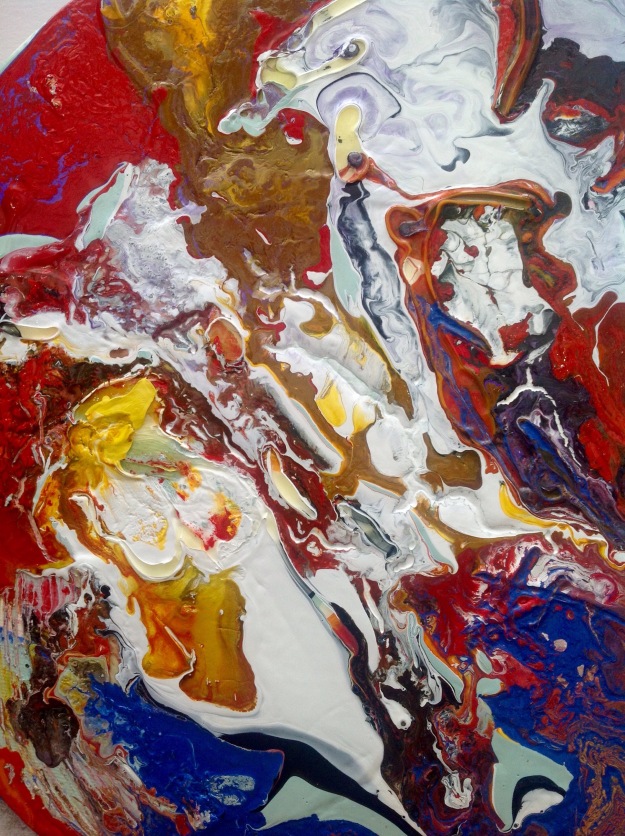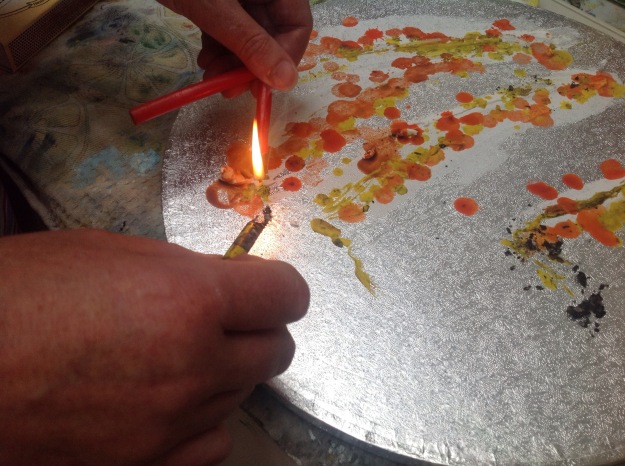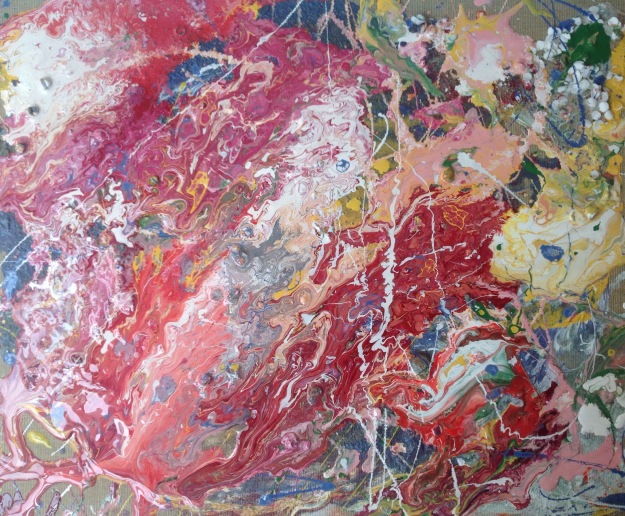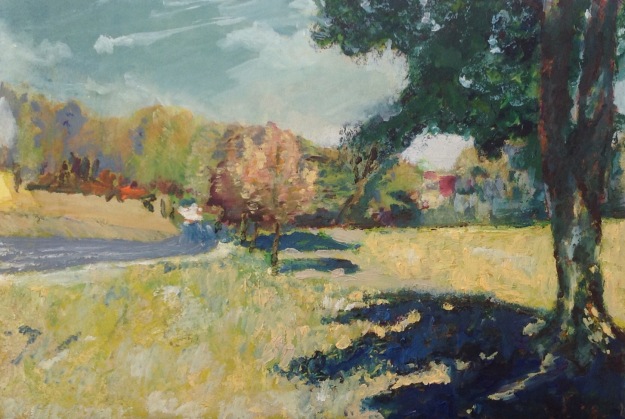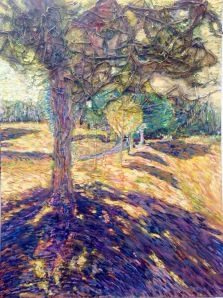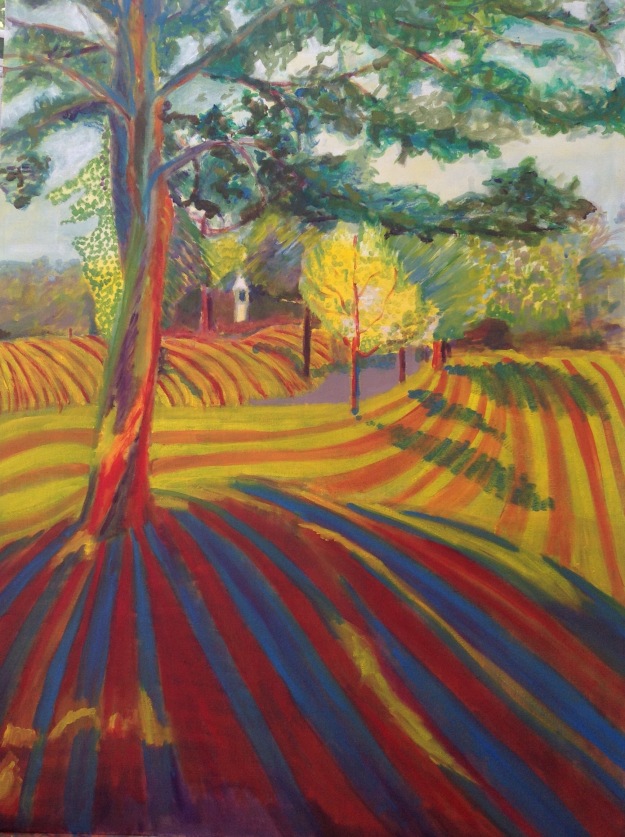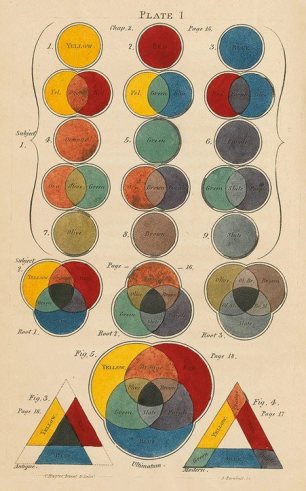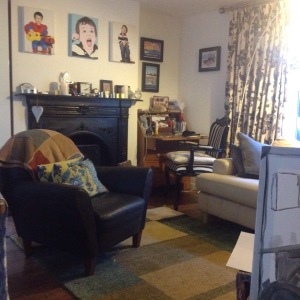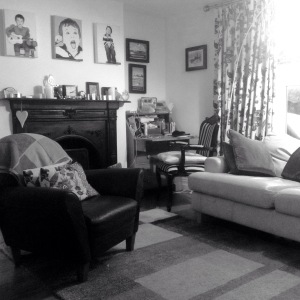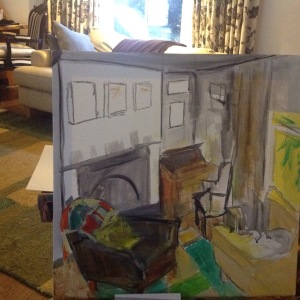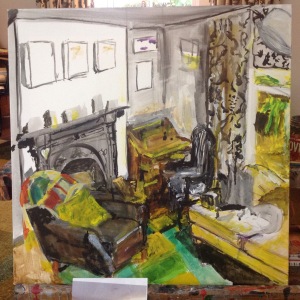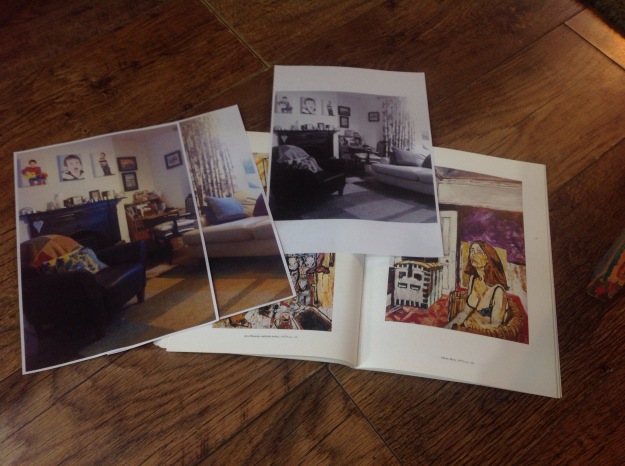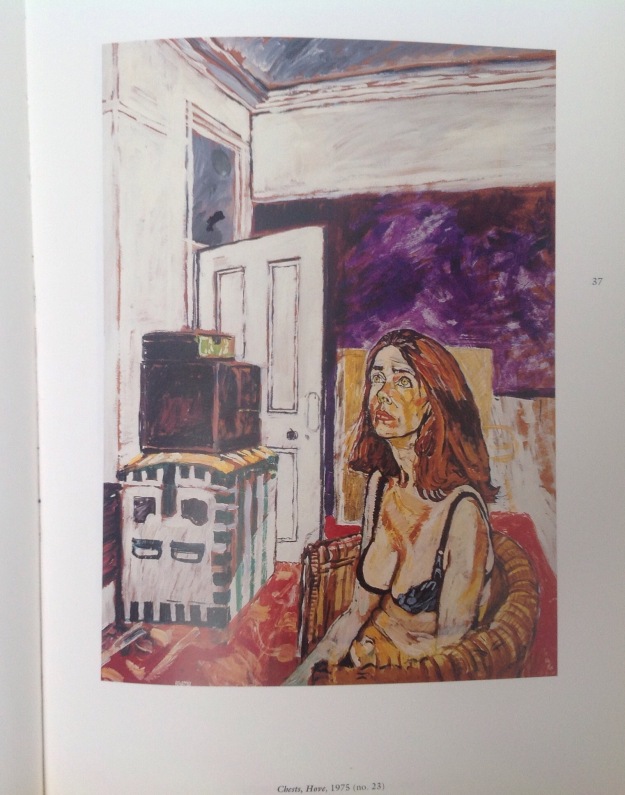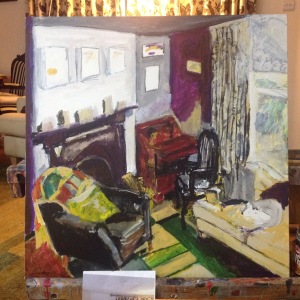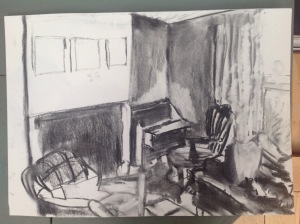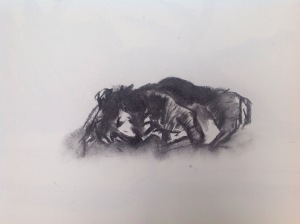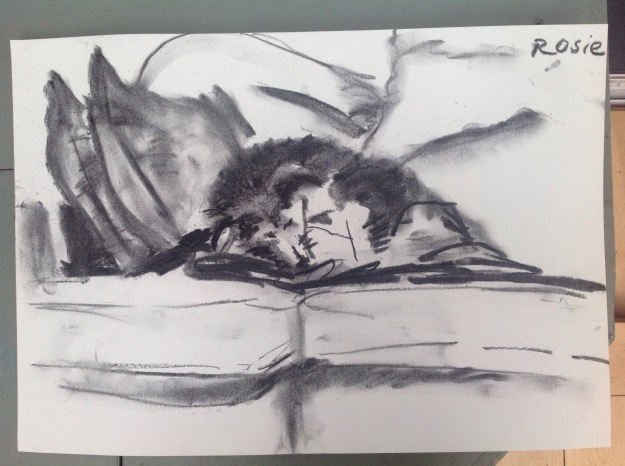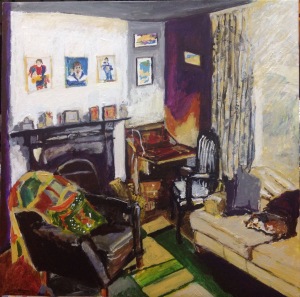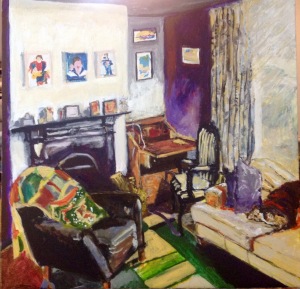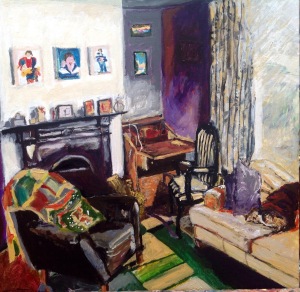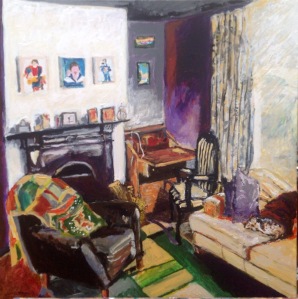I knew I would find this a difficult painting because the expectations were highly anticipated and I wanted to achieve so much. I wanted to adopt some of the experiments found in my workbook and due to the assignment being large (A1) it took time and space, But it could have been twice the size. I think I may redo it but on two A1 boards.
At the moment I am feeling very deflated by the results I received from my last assessment (understanding visual culture) so the challenge is to keep the pressure on and get this work sent before I take it all into the garden and burn it! Emotions are running high.
The reason I had high expectations was because the other paintings before were indicating a direction towards expressive abstraction with the help of some technical processors such as flattering the composition by focusing on shapes and not perspectives and working with the medium of paint and not using the paint to resemble a subject or composition. I feel that I could keep adding to this final painting and it would just absorb it without adding value. So I have decided to send it to my Tutor and give myself some space away from it. Again my work has become a fetish, where I seek a materialistic desire for the object which is the changeable and newness that this painting projects to me.
Why Landscape? The context is due to previous work painting in part 4 of this course. The artist that have influenced me are all Landscape artists such as Anselm Kiefer with ‘Song of Wayland’, David Hockney and Thomas Gainsborough with Mr and Mrs Andrews. Although I have no narrative relating to characters, I do have the drama of colour.
Torgesen Murdock’s work found in ‘100 ways to paint seascapes, rivers and lakes’.p. 28 was intriguing to me because;
- use of colour to create light and drama.
- Painting of trees in a highly contrast colour range, Colour palette was Cadmium yellow, Yellow Ochre , Burnt Sienna, Phthalo Blue, Cerulean Blue, Viridian, Alizarin Crimson and Mars Black.
- ‘Shape hunting’ is used to describe the artist design strategy where s/he looks for interesting shapes and how they will place them for full impact.
- suggests using a ‘mother colour’ to help aid colour harmony through out the overall painting. In this particular painting (Moonlight) the artist used Burnt sienna and Yellow Ochre.
I have been told not to use black by tutors and I have not, but my colour tones do get very dark. I have worked up the texture for this painting using the following;
Collage, pva, shaving foam, sand, pepper, Grass and thickened acrylic paint.
First I laid out the national geographic clippings onto the A1 board and then stuck them on with thick PVA so this would give the sheets a bumpy effect. I then cleaned the clippings with an American cleaning fluid which takes the ink and blends it or washes it completely away depending on pressure and how much fluid I use. I then carried out the paint pot drop technique which is noticeable in my previous paintings. The marbling of the colours were only used in areas of shapes such as the trees and shadows (SHAPE HUNTINGS). I then painted with Oils the areas that were still white. Added more texture, took some away and paint dropped more and then combed in some marks then washed some away. I wanted to create contrast and drama with the use of colour and the use of ‘chance’ created by the drips from the paint pot drops technique. Texture was very important which is why I think I could add more texture but not sure it would add any value. I enjoy the contrast between flat areas and areas of texture. I also enjoy the bold contrasting colours of Naples yellow and white adjacent to the Viridian tree trunk. I have given this Painting 2 coats of varnish , some is household varnish so has a tarnished tone to it.
Why? The reason I like highly contrasting colours is that it shows light and light is intensity , it helps to explain forms, the time of day and I much prefer light than darkness. Dull paintings or muted tones are still intriguing and dictate mood but I associate these with traditional work and not contemporary works. I wanted my work to become more shiny after reflecting on past work . This shiny effect of the Enamel paints and the varnishing, directs the viewer to see the painting as more manufactured and less hand-painted. Society is attracted to newness and sparkly, glamorous things as its part of our conditioned capitalist ideology. To put this theory into context I would accommodate the affection towards shiny surfaces like the attraction given to newly released films; I and most popular cultures would prefer to watch Wonder-woman 2017 than my childhood favourite of 1975; TV series Wonder-women starring Lynde Carter .So to conclude, Light and Contrast = Intensity, Drama and a clear definition between light and dark zones. It is not about being associated with grey areas, confusion or dull. I feel its associated with clinging onto youthfulness but is earnest and serious.
Some questions I need to think about for my next post; evaluating my series of paintings, referring to the following Assessment criteria;
- Development of visual and technical skills, design and composition.
- Competent realisation of ideas , presented well and showing judgement.
- Development of Analytical and creativity thinking. Showing independent judgements and presenting some indication of develop a personal voice.
- Awareness of a breadth of contexts and debates supporting your growing personal and professional knowledge and understanding.
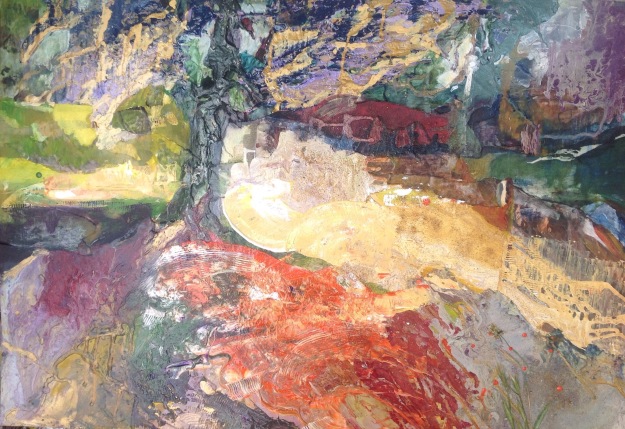
Final Painting
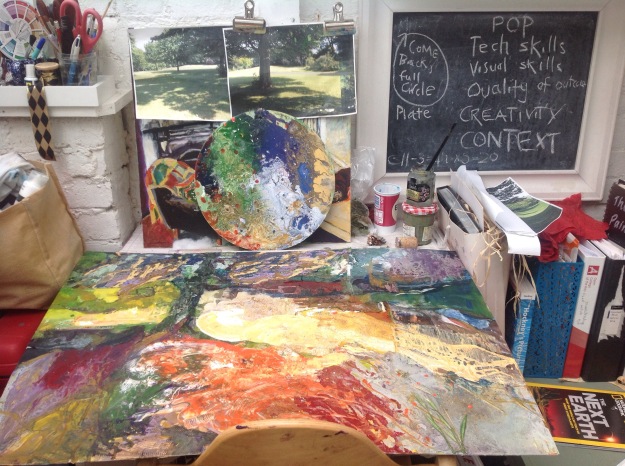
work area with images and pine cones from the park
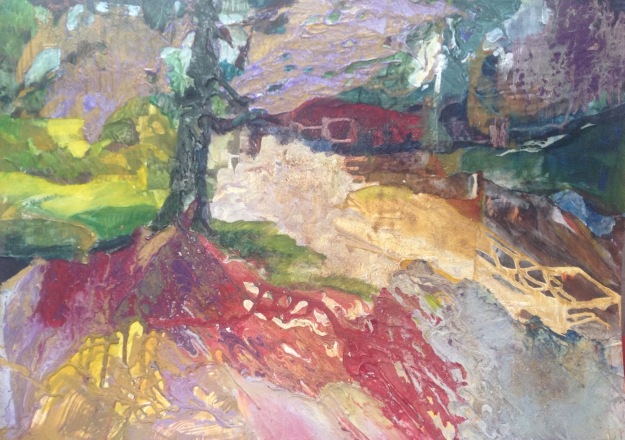
work in progress
References
100 ways to paint seascapes, Rivers and Lakes . Volume 1 International artist publishing Nevada. USA. 2004.
Oxford English Dictionary. Oxford 2005.
The Art Book by Phaidon Press Limited . London 1994.
Imbd link accessed on the 8th of August 2017;
IMDb: Wonder Woman (1 June 2017 (UK))
Before she was Wonder Woman, she was Diana, princess of the Amazons, trained warrior. When a pilot crashes and tells of conflict in the outside world, she leaves home to fight a war, discovering her full powers and true destiny.
http://www.imdb.com/title/tt0451279/?ref_=ext_shr_eml_tt (2017 FILM)
http://www.imdb.com/title/tt0074074/?ref_=nv_sr_4 (1975-79 TV series)



